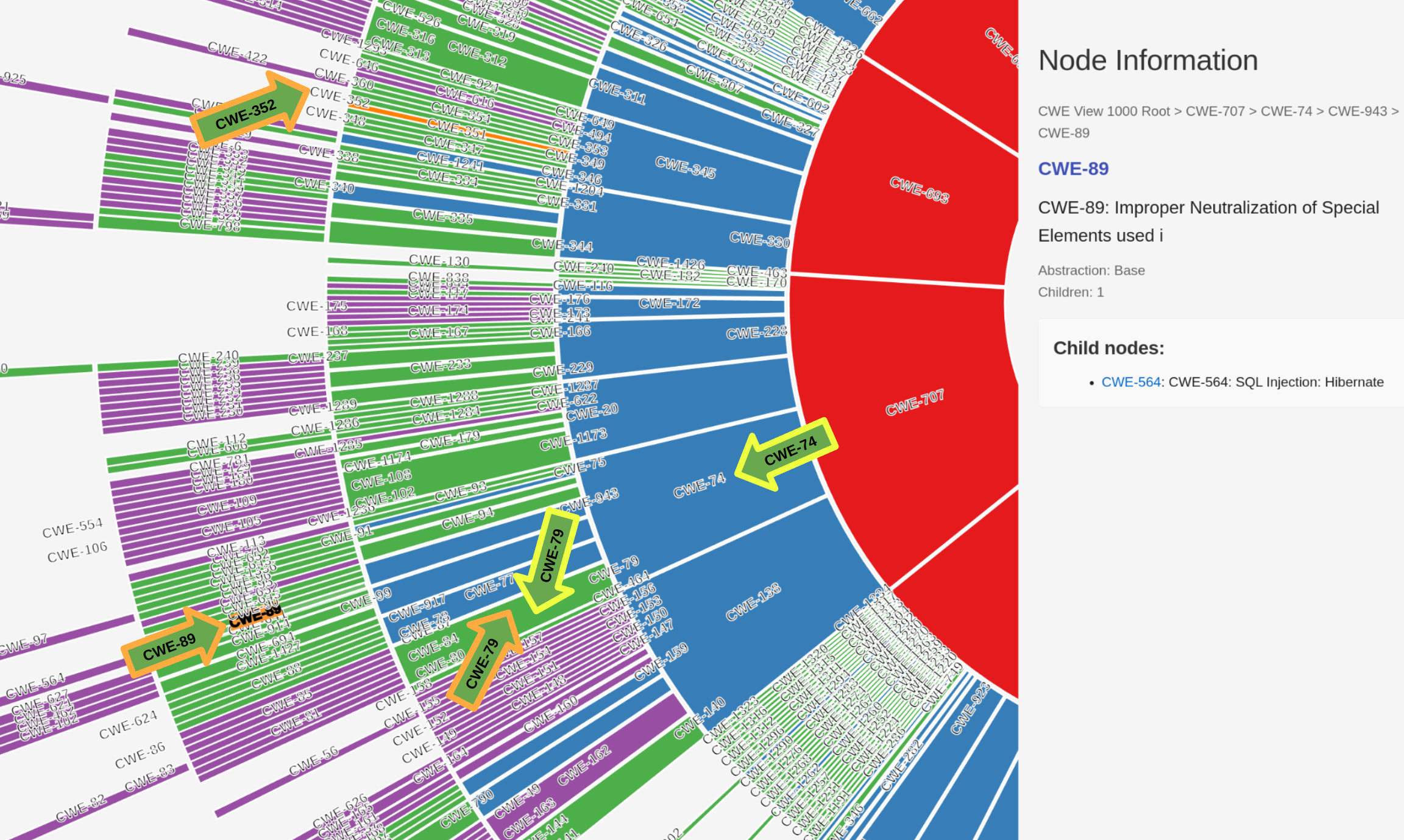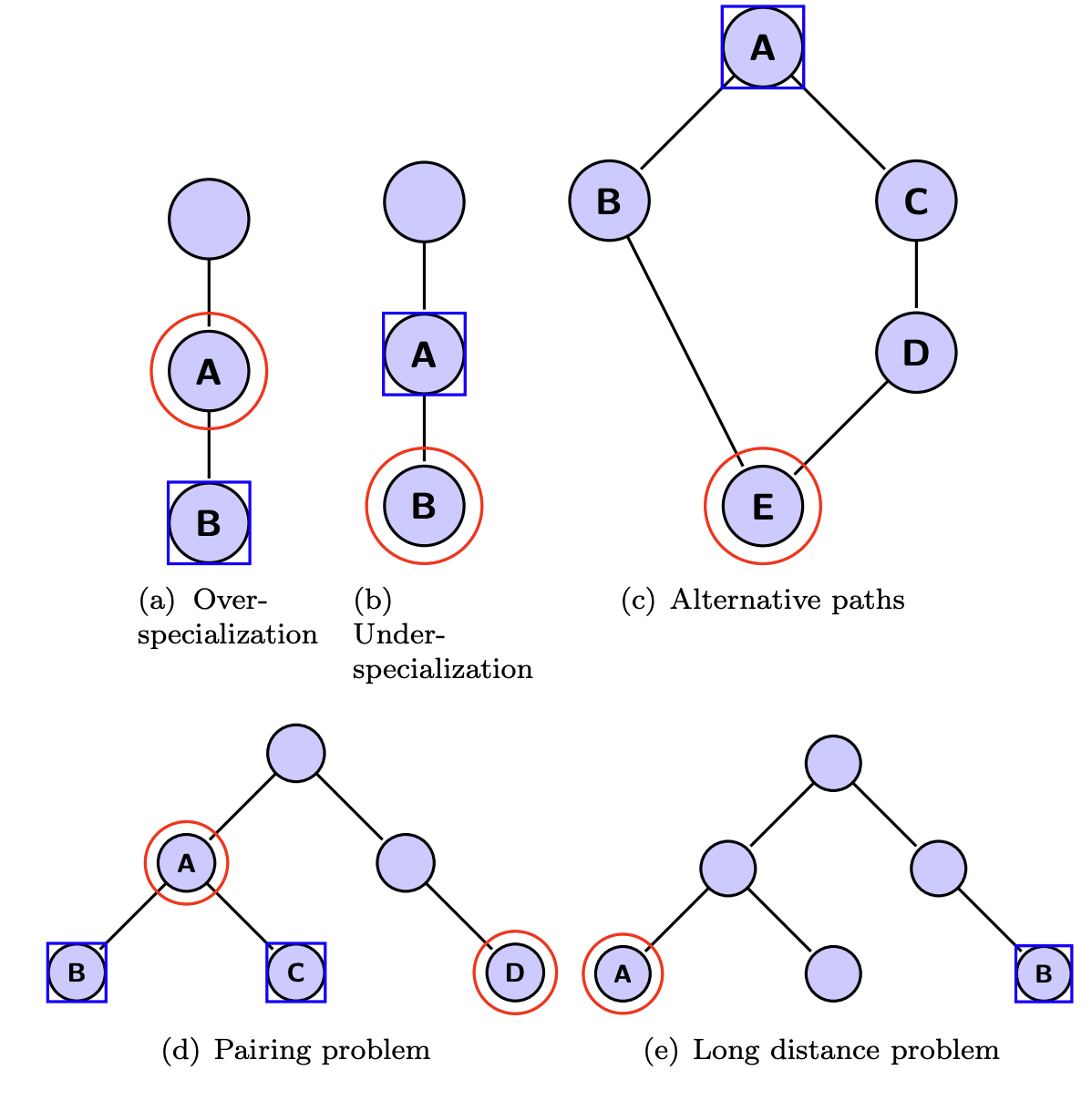CWE View for Benchmarking¶
Illustrative Scenario¶
Per Top25 Dataset, some CVEs have more than one CWE.
How do we score this scenario?
- Benchmark: CWE-79, CWE-74 (yellow arrows)
- Benchmark is the known-good CWE mappings for a given CVE.
- Prediction: CWE-79, CWE-89, CWE-352 (orange arrows)
- Prediction is the assigned CWE mappings for a given CVE from a tool/service.

- ✅ CWE-79 was correctly assigned
- ❓ CWE-89 was assigned. This is more specific than CWE-74
- Is this wrong or more right?
- Does this get partial credit or no credit?
- ❌ CWE-352 was incorrectly assigned
- Is there a penalty for a wrong guess?
Similarly, how would we score it for
- Benchmark: CWE-79, CWE-89, CWE-352
- Prediction: CWE-79, CWE-74
Question
Do we reward proximity? i.e. close but not exactly the Benchmark CWE(s).
What View determines proximity? e.g. View-1003, View-1000.
Do we penalize wrong? i.e. far from any Benchmark CWE(s).
Are classification errors in the upper levels of the hierarchy (e.g. when wrongly classifying a CWE in the wrong pillar) more severe than those in deeper levels (e.g. when classifying a CVE from Base to Variant)
Do we reward specificity? i.e. for 2 CWEs in proximity to the Benchmark CWE(s), do we reward a more specific CWE(s) versus a more general CWE(s)?
Benchmark CWE View Selection¶
Info
The most specific accurate CWE should be assigned to a CVE i.e. not limited by views which contain a subset of CWEs e.g. View-1003.
- Therefore, the benchmark should support all CWEs
Tip
Research View (View-1000) will be used as the CWE View to base benchmark scoring on.
See details on different views and why Research View (View-1000) is the best view to use.
Benchmark Scoring Algorithm¶
This section is an overview of different CWE benchmarking scoring approaches.
Data Points¶
Info
A CVE can have one or more CWEs i.e. it's a multi-label classification problem.
MITRE CWE list is a rich document containing detailed information on CWEs (~2800 pages).
The RelatedNatureEnumerations form a (view-dependent e.g. CWE-1000) Directed Acyclic Graph (DAG)
- 1309 ChildOf/ParentOf
- 141 CanPrecede/CanFollow
- 13 Requires/RequiredBy
CVE info (Description and References) may lead to some ambiguity as to the best CWE.
Scoring System: Overview¶
The goal is to assign a numeric score that:
- Rewards exact matches highly.
- Rewards partial matches based on hierarchical proximity (parent-child relationships).
- Penalizes wrong assignments.
- Provides a standardized range (e.g. 0 to 1) for easy comparison.
- Is based on the CWE hierarchy.
- Reinforces good mapping behavior.
Definitions & Assumptions¶
- Ground Truth (Benchmark): One or more known-good CWEs per CVE.
- Prediction: One or more CWEs assigned by the tested solution.
- Hierarchy: Relationships defined by MITRE’s CWE hierarchy (RelatedNatureEnumerations).
- Proximity: Measured as shortest hierarchical path (edge distance) between two CWEs for a given View.
- If there is more than one path, the Primary Path is used.
Interesting Cases¶
Evaluation Measures for Hierarchical Classification: a unified view and novel approaches, June 2013, presents the interesting cases when evaluating hierarchical classifiers.

Scoring Approaches¶
The following Scoring Approaches are detailed:
- Path Based using CWE graph distance based on ChildOf
- Path based Proposal
- See Critique
- Hierarchical Classification Standards
Tip
Hierarchical Classification Standards look the most promising.